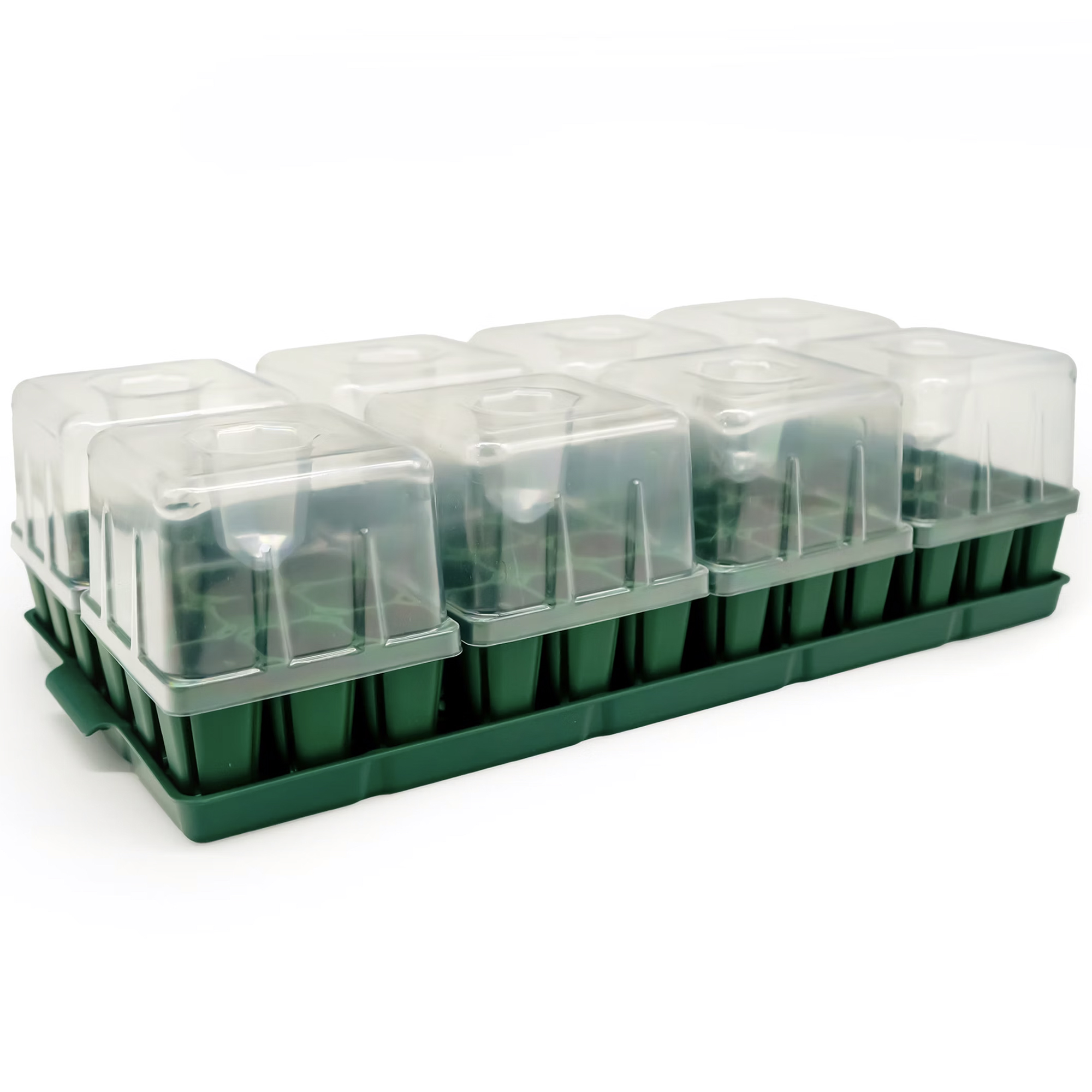How To Save Pumpkin Seeds For Planting – Plus, Tasty Ways To Eat The Leftovers!
Want to know how to save pumpkin seeds for planting in next year's garden? Here's what you need to know about saving pumpkin seeds for planting—and eating!
As you scoop the goop out of your soon-to-be jack-o’-lantern, you may wonder how to save pumpkin seeds for planting next year. Or if you’re like me, you wonder how to save pumpkin seeds to eat!
But whether you want to grow pumpkins from seed or harvest the seeds to eat, you need to know how to gather, clean, and dry them first. Below is everything you need to know about how to save pumpkin seeds for planting or to turn them into a tasty snack.
Benefits of Saving Pumpkin Seeds
There are so many creative uses for pumpkins besides carving them for Halloween. Two of the most common are saving pumpkin seeds for planting and eating.
If you want to know how to save pumpkin seeds to plant in the garden, be aware that some pumpkins do not come true to seed. Instead they cross pollinate, which can be a problem.
Pumpkins cross pollinate with other members of the Cucurbit family like squash, cucumber, or melon. This means if you plant these crops close together, the seeds you harvest may grow into an amalgamation of a pumpkin and another Cucurbit crop.
If, however, you separate your Cucurbit crops you can harvest true seed. Commercial growers stop cross pollination by separating crops by at least half a mile to get true seed. The best bet is to use a pumpkin that is an heirloom or open pollinated plant, not a hybrid.
When eaten in moderation, pumpkin seeds are quite healthy. They are high in fiber, contain antioxidants and are a good source of heart healthy unsaturated fats, polyunsaturated fatty acids, and omega-3 fatty acids. There are also many uses for pumpkin seeds in the kitchen other than roasting.
Sign up for the Gardening Know How newsletter today and receive a free copy of our e-book "How to Grow Delicious Tomatoes".
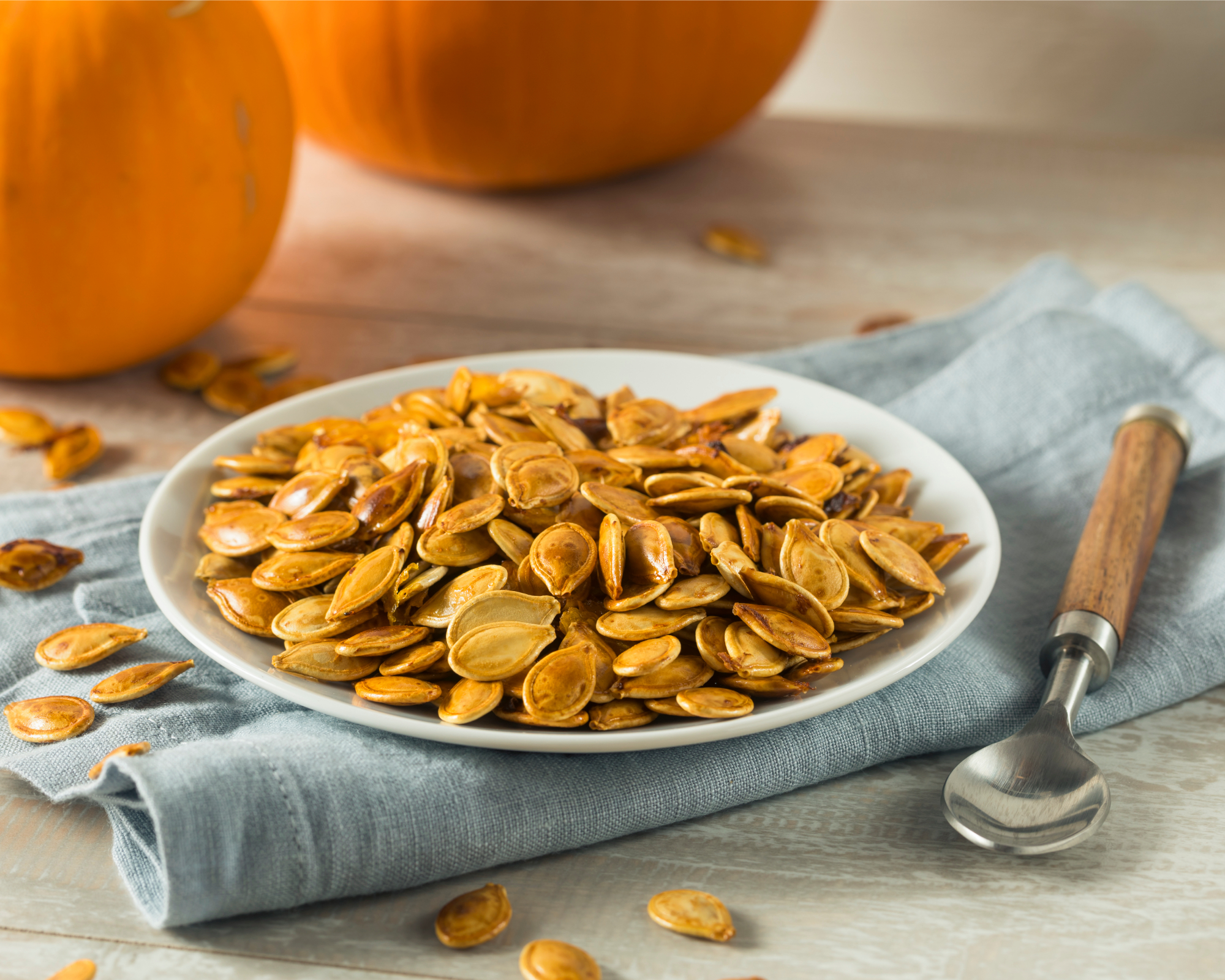
How to Harvest Pumpkin Seeds
Whether you want to learn how to save pumpkin seeds for planting or eating, the harvesting process is the same and easy to do with a few simple seed harvesting tips.
- To harvest pumpkin seeds, start with a large, healthy pumpkin. Wash the pumpkin and dry it to remove any dirt or debris and then cut it in half with a sharp knife.
- Scoop the seeds out with a spoon. Wash and rinse the seeds with clean water until the pulp separates from the seeds, then drain the seeds in a strainer.
- Remove the pulp and seeds from inside the pumpkin. Place this in a colander.
- Place the colander under running water. As the water runs over the pumpkin innards, separate the pumpkin seeds from the pulp by picking out seeds and letting pulp run out of the colander. Rinse in the running water as you complete this step.
- There will be more seeds inside the pumpkin than you will likely need to plant, so once you have rinsed a good amount of seeds, look over them and choose the biggest ones. Plan on saving three times more pumpkin seeds than the number of plants you'll be growing next year. Larger seeds have a better chance of germinating.
- Place the rinsed seeds on a dry paper towel. Make sure they are spaced out; otherwise, the seeds will stick to one another.
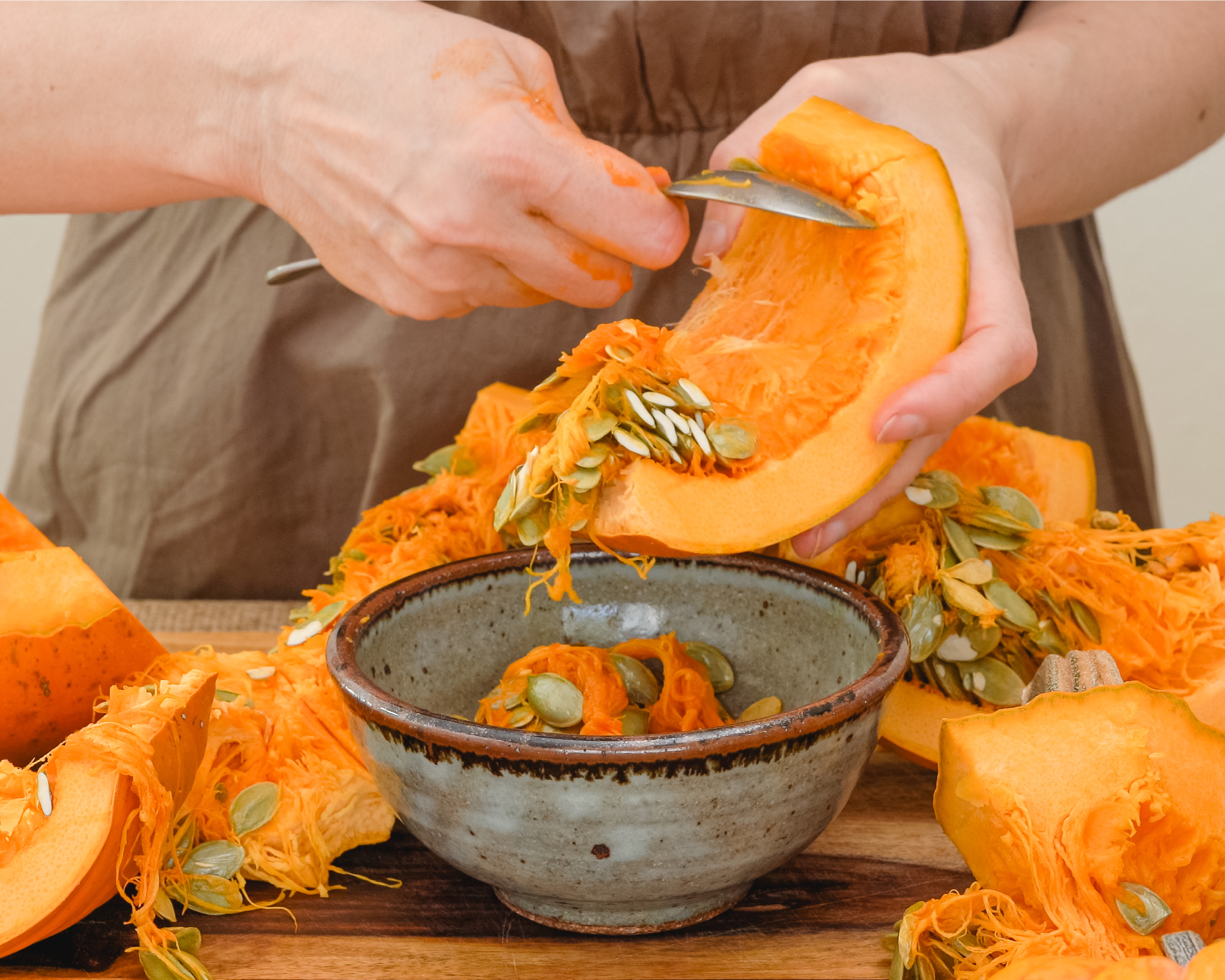
How to Save Pumpkin Seeds
Once you’ve separated and cleaned the seeds, the process for saving them varies a bit depending on whether you’re saving them for planting or eating.
For Planting
Lay out seeds in a single layer; on an old window screen or the like is perfect. Allow them to dry for a few weeks, turning them over for the first few days.
Once they are dry, package the seeds in paper envelopes then date and label them. Store seeds in a cool dry area for up to a year. Or you can store pumpkin seeds in a sealed plastic bag and store them in the refrigerator. Properly stored pumpkin seeds may remain viable for up to four years.
For Eating
Harvest pumpkin seeds for eating the same way you would for planting, then dry in the same manner or use a dehydrator. Set your dehydrator to 115-120 F (46-49 C) for 1-2 hours or in the oven on warm for 3-4 hours. Stir the seeds frequently to ensure even drying.
Once the seeds are dry, you can roast them. At this time you can add additional seasonings, if you like, or toss them with a little oil and salt before roasting.
If you want to de-hull your seeds to make them a bit easier to eat, you must boil and dry them first before roasting. Hulls slide off seeds after boiling or you can crack and remove them manually before eating. Usually the hull isn’t too thick and there isn’t really a need to remove it.
There are also pumpkin varieties that have hull-less seeds, often called pepitas, though there are a few differences in pepitas vs. pumpkin seeds. If you are using a hull-less variety, skip the hulling step above.
How to Store Pumpkin Seeds for Planting
When saving pumpkin seeds for planting next year, store them where they will remain viable for many months. All seeds, pumpkin or otherwise, store best when kept somewhere cool and dry.
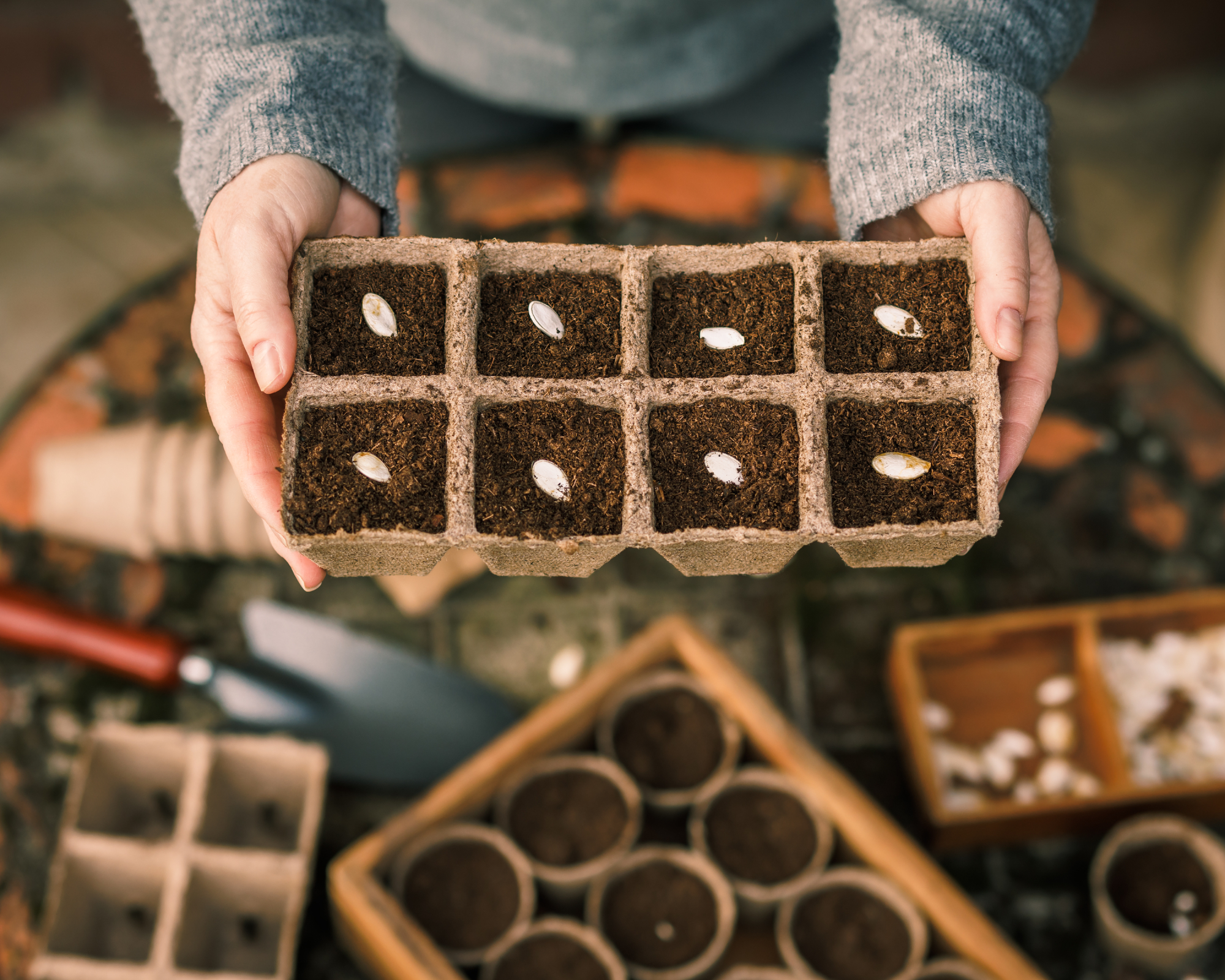
One of the best ways to store seeds, including pumpkin seeds, is putting them in your refrigerator. Place your pumpkin seed envelope in a plastic container, then make several holes in the lid to ensure condensation doesn't build up on the inside.
Place the container with the seeds at the back of the fridge. Then next year, when it comes time for planting pumpkin seeds, yours will be ready to grow.
How to Roast Pumpkin Seeds
You can opt to roast pumpkin seeds in the oven or microwave, or boil and then roast them in the oven.
To roast in the oven, toss seeds with a little oil and salt as well as your favorite seasonings. Roast at 250 degrees F (121 C) for 10-15 minutes, keeping a careful eye on them so they don’t get too brown.
If you would rather roast the seeds in the microwave, pat them dry first. Melt 2 tablespoons of butter in a microwave-safe dish then spread a single layer of the seeds atop the melted butter. Microwave on high for 7-8 minutes, stirring every two minutes. Remove from the microwave and season with salt and any other seasonings you’d like.
You may also boil the seeds in salted water for half an hour, drain and dry, then roast in a shallow pan or cookie sheet for 30-40 minutes at 300 F (149 C). Stir the seeds every 10 minutes to ensure even roasting.
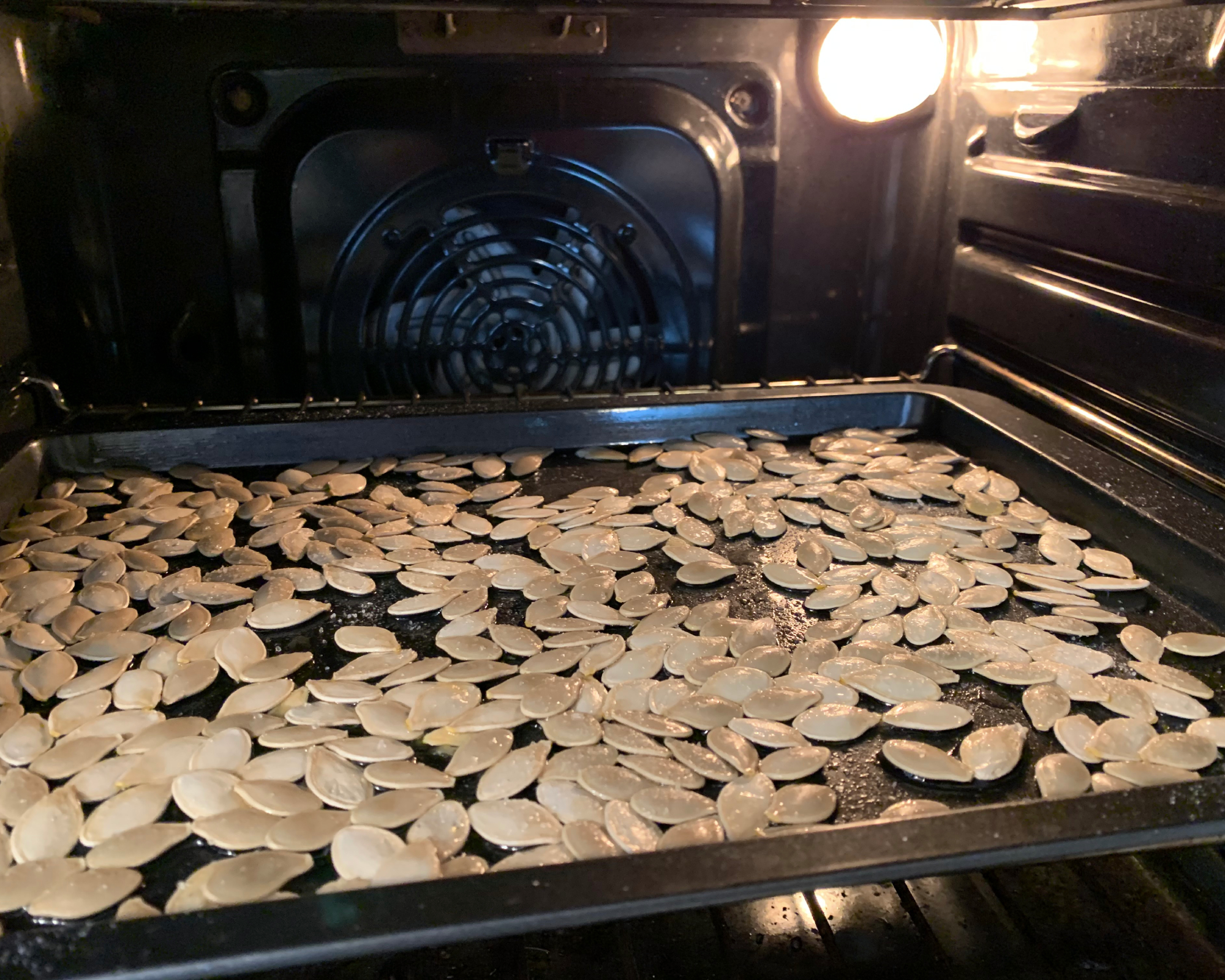
If your hulls were thick and you opted for removal, you can toast the hull-less seeds instead of roasting them. This is a different, though equally tasty, take on the classic fall favorite. Cook seeds in a skillet over medium-low heat until they begin to pop and smell nutty.
Once your roasted or toasted seeds are cool, store them in an airtight container at room temperature or in the refrigerator to extend their shelf life.
Frequently Asked Questions
How long do pumpkin seeds last?
Under the right conditions, you can store pumpkin seeds for up to four years. Store dried seeds in a cool, dry area for up to a year or store them in the refrigerator to extend their lifespan.
Can you plant pumpkin seeds straight from the pumpkin?
Probably. The issue isn’t if you can plant fresh seeds from a fresh pumpkin, the problem is that pumpkins mature in the fall but are planted from seeds until the spring. You would need to store the seeds for months prior to planting and the only way to do that without them getting moldy is to dry them first.
Love Gardening Know How? Our latest book, The Complete Guide to Vegetable Gardening, is available now!
Perfect for the gardener in your life, or for your own coffee table, this book boasts 224 pages of high-quality pictures, expert tips, and easy-to-follow advice to get your vegetable garden growing its best. Look for it at these sellers, and wherever quality books are sold.
This article features products available from third-party vendors on the Gardening Know How Shop.

Amy Grant has been gardening for 30 years and writing for 15. A professional chef and caterer, Amy's area of expertise is culinary gardening.
- Amy DraissDigital Community Manager
- Laura WaltersContent Editor


